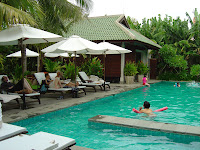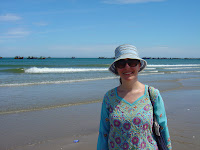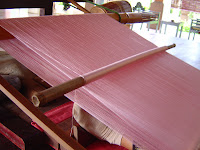Tuesday, September 1, 2009
How to brief a copywriter
The most important thing is for you to have done your research. Know who your customers are; know who your competitors are; and understand your own brand: what it is that differentiates you from the crowd, and how you show that in everything you do.
Then you need to think about the specific project you want copy for. Provide details of exactly what it is, how long/how many pages, how you want the information to be broken up, and what sort of information you want in each section. If you have any supporting material, such as previous items, or copy you have written yourself, so much the better. The more detail you have thought through, the easier it will be for the writer to concentrate on writing brilliant copy-and the less time they will have to spend on it-which in turn affects how much you will pay.
Then you can sit back and relax-or get on with something else-because delegation to a professional is all about getting results you couldn't achieve on your own.
Monday, July 20, 2009
The Importance of Consistency
If you are not familiar with the concept of editorial style guides, read on for an explanation of what they are, why you might want one, who uses them and what they cover. Also included is a simple way to go about developing a house style guide for your organisation.
What is an editorial style sheet, guide or manual?
Style, in this context, has nothing to do with graphic design, the font you choose or even the tone or type of language you use. An editorial style guide records decisions you have made about how to present certain things in the writing you produce. When you write anything new for your business, you can check the style guide for the styles used in previous publications. Examples are: idiosyncratic spellings; whether you use an em dash or an en dash (see below); or how to present numbers and dates. There is no right or wrong about style decisions, but once you have established a style, it is best to stick to it and be consistent. Otherwise, your writing could look unprofessional and sloppy.
Why should I care?
People judge by appearances. Most of us dress to demonstrate our professionalism to our clients, and keep any public areas in our offices tidy. Attention to detail can be even more important in the documents produced by a business. They must be spelt correctly, grammatical - and presented in a consistent style. You don't want potential clients wondering what other things you can't be bothered to get right. Additionally, when a business has a defined house style, staff and consultants can refer to it in order to produce material that is consistent with other house publications.
Who uses them?
Book editors have a separate style sheet for each book; publishers also have an overall house style. The Australian Government has a style guide: Style Manual for authors, editors and printers, currently in its thoroughly revised sixth edition, which covers all governmental publications. This manual is a useful reference for anyone producing publications of any type within Australia as the default style, for anything not covered in a specific style sheet or guide. Businesses, too, benefit from having a house style, recorded in a style guide. It can be anything from one page to a booklet, and will set the style for any publication made for the business, in print or electronic form.
What goes into a style guide?
Things that may be covered in a style guide include:
- Spellings of words that may be unusual, foreign or idiosyncratic. These are listed alphabetically, so you can look them up easily. (Examples: personal names; technical terms. Additionally, you may choose to present foreign words, not commonly used in English, in italics, to flag to the reader that the word comes from another language.)
- Australian or US spellings. (Examples: colour and realise vs. color and realize.) Australian spellings are appropriate for any material intended for an Australian or broadly international audience; however, a business that directs its marketing specifically to the US should use American spellings.
- Any abbreviations used within the document. (Examples: NSW; Bros.)
- Quotation mark style. (Examples: As a rule, newspapers use double marks, with single marks within a quotation; book publishers usually use single, with double within.) It does not matter which style a business chooses, so long as it is consistent within all documents.
- Use of em or en dash. (Examples: The em dash is long (the length of an 'm')-like this-with no spaces; the en dash is shorter (but longer than a hyphen: it's the length of an 'n') - like this - and always has a space on either side.) Only one should ever be used: choose the one you prefer. Keyboard hint: for an em dash on a computer keyboard, press Ctrl + Alt + the minus sign on the number pad. The en dash is obtained by pressing Ctrl + the minus sign on the number pad. For hyphens, use the short dash or minus sign alone.
- Capitalisation and punctuation (if any) of headings and captions. (Example: whether headings or captions are in title case or sentence case.) Often a first level heading will be in title case, and subsequent levels in sentence case, as in this article.
- Punctuation of bullet points. (Examples: Capital letter or not at the beginning of each point; full stop, semi colon or no punctuation at the end.) Minimal punctuation is generally accepted as usual nowadays, unless the bullet points contain full sentences/paragraphs, as in this article.
- Where numbers are expressed as figures or spelt out. (Example: often, numbers up to and including ten or twenty are spelt out, and figures used after that.)
- Dates and years. (Examples: 12 November 2009; 12/11/09; 12th Nov '09; Twelfth November, Two thousand and nine.) Again, make a decision and stick with it.
- Time. (Examples: 11.15 pm; 23:15 hours; quarter past eleven at night.)
- Dollars and cents. (Examples: $150 or 150 dollars; $1,000,000, $1 million dollars or one million dollars.) There are thousands more style decisions that could be made for a house style; a single publication may only need a few.
Developing a house style doesn't need to be complicated. A simple way is to start a guide while working on your next publication. Make a few preliminary decisions, and then add more to the guide as they come up with each new publication. This is much less overwhelming than trying to think of every eventuality all at once.
As a copywriter, I like to begin by asking the client for a style sheet or manual, if there is one. If not, I will create one for the publications I am working on. I present this early on, so the decisions I make can be approved. Then if required, I submit the end result with the final copy, so the client can use and build upon it in the future.
You can access the template that I use for a single publication style sheet here. Start adding your own style decisions, and you're on your way to having your own house style.
(c)Linnet Good 16 February 2009. Linnet Good, of Goodscribble, is a copywriter, editor and desktop publisher. You are welcome to reproduce this article, but please acknowledge the author. No editing/omissions/additions to the article text without prior approval. Linnet can be contacted at goodscribble@gmail.com.
Monday, June 29, 2009
Spell cheque is knot awl ewe knead!
Proofreading really should not be viewed as an optional extra when it comes to business communications. Your credibility and professionalism are called into question every time you produce an error of this kind. Once or twice in a blue moon can be forgiven-we all make mistakes-but more than that, it just looks sloppy.
Proofreading your own writing is difficult, because you are so close to the material. It is much better to have another person look over it, and ideally, that person should understand the rules of spelling, grammar and syntax. A professional proofreader doesn't have to cost a lot, and they bring expertise as well as fresh eyes to the job.
Failing that, print out the copy, take it and a pencil somewhere quiet, and go over it slowly. Proofreading requires concentration. Do it after a good break from the writing, preferably after a night's sleep.
Make several passes through the document to catch different things: spelling, extra/missing spaces, consistency of terms or headings, etc. A good trick for catching spelling errors is to go backwards through the text, looking at each word. To catch clumsy phrasing and other errors, read the whole thing through out loud. Check headings, links, names, phone numbers and addresses. Use a good dictionary and thesaurus for checking words, meanings and alternatives.
Publishing or posting well-checked copy is worth the effort, since it reflects on your business. Printed disasters can be pulped, but online communications stay on the web for a long, long time, and will turn up any time someone Googles you. It's good to keep that in mind every time you write something online, even if it's only a tiny comment.
Wednesday, November 5, 2008
Bac Ha
In the evening, we left most of our luggage at the hotel and took the overnight train to Lo Cai. (Thankfully I had recovered by then.) This northern-most town is just across the river from China – you can wave to it from there! Locals travel across the bridge every day to buy up cheap and nasty Chinese goods for resale in Vietnam. There we met our regional guide and had breakfast in a cafe.
 Thousands of tribal Hmong people walk into town from their mountain villages to sell their wares and buy supplies, eat weird/scary-looking stuff (I'm not even going there) and drink too much of the impressively strong local corn liquor.
Thousands of tribal Hmong people walk into town from their mountain villages to sell their wares and buy supplies, eat weird/scary-looking stuff (I'm not even going there) and drink too much of the impressively strong local corn liquor.


Later, we went on a short hike nearby where we visited an elderly man whose nickname we were told was Uncle Ho (we assumed from this that he had once been in the Viet Cong). Full of charm and vitality, he pressed corn liquor on us (no was simply not taken for an answer in his house), played a local instrument made of bamboo, sang and danced. It was very much an interactive experience: we were encouraged to play and dance too, to amusing effect.

We tottered back to the hotel, feeling the effects of the corn wine. On the way we encountered some y
 oung Flower Hmong girls who were cross-stitching as they walked.
oung Flower Hmong girls who were cross-stitching as they walked.
Sunday, October 26, 2008
Hoi An
 (Written 28 September 2008)
(Written 28 September 2008)From Dalat we made our way back to Saigon, where we drove through that damn peak hour traffic again (thanks to Jetstar bringing forward our original departure time) to the airport, from whence we flew to get to Hoi An.
We stayed in a lovely little hotel (little is the word, too – all the rooms were tiny) where the owners and staff were all exceptionally nice and helpful. The food and drinks were all very good, too. Many were the wonton soup orders from our group, as it was particularly delicious.
We did notice that when a food order was made, from the balcony we would see a man head out on his motorbike. Later, he would return with something in a plastic bag, and a few minutes later, lo and behold, our food would be served. It must have been frustrating for him when we all ordered one after the other, as often happens with a bunch of people all doing different things.
The hotel is just near the old town, which has been/is being restored to its former – if not grandeur, perhaps glory would be the word. Lots of small but very lovely old buildings, some of which you can visit inside. It is amazing how much cooler inside they were than out, with no airconditioning, just clever use of breezes, water and shade.
In the town there are also many, many local handicrafts of varying quality, thousands of make-to-order tailors and shoemakers (most of which we were advised to avoid) and a very few truly exceptional shops.
On our way there, I had bought some beautiful silks, which I then had made up into the traditional costume of Vietnam – a very flattering garment – which makes one look as if one has long legs right up to the waist.
The food in the touristy bit was not as good as where the locals ate, as you might imagine. Such a shame when things get westernised, especially since the local food is so very good.
We went to a cooking class at the Red Bridge cooking school. It starts with a tour of the market in Hoi An, followed by a boat ride up the river to the school.
 The recipes were divine, the chef hilarious and there was even a pool to chuck your kids in for the duration (or yourself, after you've eaten the meal you've cooked).
The recipes were divine, the chef hilarious and there was even a pool to chuck your kids in for the duration (or yourself, after you've eaten the meal you've cooked).
One night, Pauline, Jodie and I went for a walk into an area much more frequented by locals and saw more of the way they live there. On our way, we were approached by a woman with two small girls. She asked us where we were going, and when we told her that we were 'just walking', she invited us to come and see her house. So we visited for half an hour or so, chatted and played with the girls, who were charming.
She showed us the marks on the walls that showed how high the last floods had been – over a metre up from the floor. Apparently it happens for a few days every year, and everyone has to move everything up into a second story and live on instant noodles while it lasts. She told us that it was exhausting, which we could well believe: we're talking having to move the fridge and freezer, among other heavy items.
Everywhere we go in Vietnam seems more beautiful and wonderful than the last place, but I think the truth is that it's all gorgeous, in different ways. Our next stop was Ha Noi.
Mui Ne and Dalat


We left Saigon for Mui Ne, a beach-side town, where we stayed in a pleasant resort that is usually frequented by Vietnamese tourists. These have a habit of all going together in large family groups, of bringing their own food and snacks (they want it cooked just they way they are used to) and of singing songs in a rousing chorus before and after dinner, more and more drunkenly. Unlike your average Australians would be, drinking beer in such large groups, these people were all rather sweet and not at all offensive in their behaviour.
Next door was the almost unbelievably opulent Pandanus resort. No matter where you go in the world, you can always find somewhere to stay that will cost you hundreds of US dollars a night. This was one of those. We cheekily made full use of its facilities: silk weaving demonstrations in the vast lobby, full body massages in the spa and swimming in the fabulous, undulating pool.
Then it was on to Dalat in the mountains, where the French were once wont to go to escape the heat, and where they had built many large and beautiful villas that are now lived in by the well-off, when they are not sadly abandoned instead. People in Dalat are noticeably fashion-conscious, and tend to pile on the layers, despite the fact that it's not really all that cold.


Later, we went to a small place that makes beautiful hand-woven cloth, where we bought up big and were entertained by a very cheeky little girl who played hide and seek with us.
In the afternoon, we went to the head office of a silk embroidery company, which is set up as a museum complete with tour guide and a series of shops at the exit. the embroideries are of an extremely high level of skill, and frequently of an enormous size. The embroiderers are considered artists and their job is a calling.
 It was the most perfect expression of the frustration of this kind of high-precision work. As our group are all crafters, we could very much relate! Fortunately, the company decided to assist her to continue and she is now one of their highly skilled artists. They decided to display the slashed work as an illustration of how difficult the work can be. (Not that we were in any doubt!)
It was the most perfect expression of the frustration of this kind of high-precision work. As our group are all crafters, we could very much relate! Fortunately, the company decided to assist her to continue and she is now one of their highly skilled artists. They decided to display the slashed work as an illustration of how difficult the work can be. (Not that we were in any doubt!)
Saigon and the Mekong Delta

(Written 19 September 2008)
Saigon ... shit.
Actually, it's not shit at all! It's beautiful.
I'm on a food and textile tour of Vietnam, with my mother and six others. Our tour guide, a very lovely woman who was born here, grew up in France and is now an Australian citizen, is a textile student at RMIT, and this is her first attempt at putting together a thing like this. And - so far so good!
We arrived safely, driving through the peakest peak hour rush I've ever seen (you would never have known that many motorbikes and mopeds were possible on one road) to get to our guide Pauline's grandparents' house for dinner. Her grandma had been ill, and was still in hospital, but was expected home the next day. But we met her grandfather, and her aunts and uncles and cousins, and had a lovely meal, which was too enormous for us to finish.

We had an amazing day today. We left early and drove to the Mekong Delta, where we got onto a boat, which took us to an island where we had a tropical fruit degustation (yum!) and were serenaded by some traditional musicians. (Three very cool dudes - on a guitar and two instruments that looked like large wooden banjos - and a singer).
Then we hopped into three separate canoes (there are eight of us on this trip, including Pauline) and were paddled down a waterway where we hopped on to another boat - which promptly broke down. As we drifted along the mighty Mekong, waiting for another boat to pick us up, we congratulated Pauline on organising this gentle, relaxing part of the day, and suggested that she build it in to future tours.
Eventually, we were rescued, and taken to a much smaller boat (tho' bigger than the canoes), which took us up a canal. Remember the scenes in Apocalypse Now, when they're travelling up a canal in a small boat? The surroundings were so like that I had a freaky flash of the movie in my head.
It was SO amazing to be looking at the terrain that I've only ever heard about or seen in movies, and to have it brought home so vividly just how completely and
 utterly the Americans and their allies were OUT OF THEIR DEPTH in this country.
utterly the Americans and their allies were OUT OF THEIR DEPTH in this country.As Pauline put it, how on earth do you defeat people who can disassemble tanks in China, carry the parts all the way back home through the jungle, and then reassemble them to fight you? The sheer determination, skill and profound knowledge of country!
We visited a coconut candy 'factory' - a thatched shelter with five or six girls making and speed-wrapping the most delicious candy, and then went back down the canal a bit to have lunch.

Lunch was fabulous, and served by a cheeky-charming young man who made us all laugh, and who had taught himself his excellent English through serving tourists in the restaurant (which was perched on a platform on the canal, by the way, in amongst the palms). We ate whole fried fish, pieces of which were pulled off and wrapped into rice paper rolls and dipped into a tamarind sauce that was truly excellent. Oh, and a barbecued king prawn each.
When I say king prawn, I don't mean the measly sort you get in Australia. I mean a KING prawn. Easily about 30cm long, unfurled, not counting the two very long clawed arms that were like a narrow, elongated crab's. The meat was dipped into a delicious salty lemony mixture, and eaten with much lip smacking gusto.
We finished up with sweet, milky iced coffee - perfect.
Eventually, we said our fond goodbyes, and rolled back down to the boat, putt-putted back down the canal, back into the bigger boat, and made our way back to the mainland. Some snoozed on the way home - we were all very tired, but happy.
This evening, some of the knitters among us found a lady selling bamboo knitting needles, and then a lady selling yarn. Most of it was crappy acrylic, but she also had some really beautiful, lustrous mercerised cotton in fabulous colours, so now we've all got a new project to be getting on with.
Dinner was at a rice paper roll restaurant, while Pauline went to visit her grandmother, who would have just come home from hospital.
Tomorrow we leave Saigon - for the beach, apparently! I've bought a swimsuit in anticipation: I haven't owned one since the one I bought in Avignon in 1985 died.
Everything's very cheap - I'm going to have to be careful.








